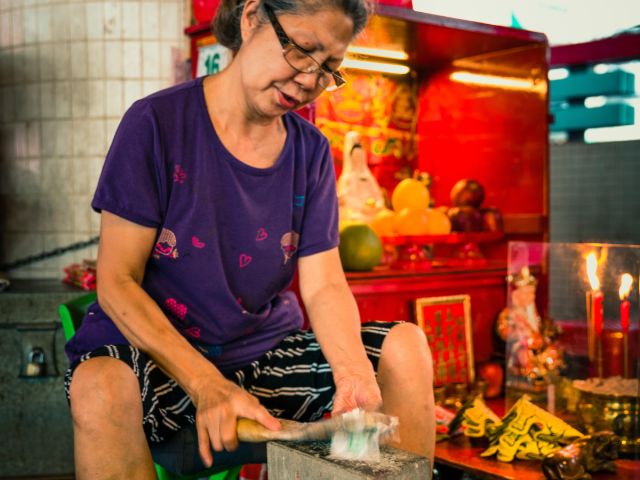
A city that reveres the old as much as the new, Hong Kong is a modern metropolis that’s also home to countless time-honoured traditions. From fortune-bringing practices to exercises that strengthen the mind and the body, many of these rites and ceremonies still play an important role in the daily lives of local residents. If you want to experience life as a true Hong Kong native, here are some fun traditions to check out when you’re in town.

Chinese herbal tea
Bittersweet may be the best way to describe Chinese herbal teas. Called leung cha in Cantonese, which literally translates to ‘cooling tea’, these brews are a major part of the wellness regimen for many Hong Kong people. Often dark and astringent, these beverages can be made with different herbal ingredients, each with their own purported health benefits. Common brews include 24 herbs — known as a cure-all that can also help you detox — and five flower tea, which soothes symptoms associated with excess heat and dampness.
These teas are so integrated into the local culture that you’ll find them everywhere in the city, from traditional herbal tea shops — such as Kung Lee Herbal Tea Shop
{{title}} Address {{address}} Website {{website}} More info , which specialises in sugar cane drinks, and the century-old Good Spring Company — to modern chain stores that sell bottled brews for convenience. If you fancy boiling up a batch at home, you can also find prepacked ingredients at local supermarkets.

Chinese Medicine
With Hong Kong’s East-meets-West heritage, it’s not surprising that Traditional Chinese Medicine (TCM) shares equal importance with its Western counterpart. While remedies — often involving herbs, roots and animal parts — may seem exotic or downright bizarre to tourists, they draw upon more than two centuries’ worth of medical systems, practices and findings. If you want to learn more about this ancient form of healthcare, consider getting a consultation at one of the many registered Chinese medicine clinics in the city, such as the one housed within the historic Lui Seng Chun
{{title}} Address {{address}} Website {{website}} More info building in Mong Kok. It’s also worth visiting Sheung Wan’s Ko Shing Street (Chinese Medicine)
{{title}} Address {{address}} Website {{website}} More info , which is clustered with shops and wholesalers specialising in TCM remedies.

Feng shui
The traditional Chinese practice of feng shui (meaning wind and water in Cantonese) aims to bring about harmony — and luck — through the placement of objects in relation to their natural surroundings. While its origins can be traced back to more than 6,000 years ago, the practice is not only still alive in Hong Kong today but is very much thriving, with feng shui consultations being quite the norm among locals.
Synonymous with prosperity, good feng shui is desired in everything from the layouts of humble apartments to the look and even location of the city’s tallest skyscrapers. To see feng shui principles in practice, head to the HSBC Main Building
{{title}} Address {{address}} Website {{website}} More info in Central. Many of its features — including the cannon-like structures on the roof, its hollow atrium and the two bronze lion statues that sit regally by its entrance — were constructed after consultations with feng shui masters. If you continue to look up while exploring the city, you’ll also notice that some high-rises have holes designed into them. These ‘dragon gates’ are said to allow dragons and positive energy to flow through, and are another architectural feature informed by feng shui.

Tai chi
You may know about tai chi from kung fu movies, but this ancient martial art is popular in real life too in Hong Kong. Practised as a form of self-defence as well as a meditative exercise, tai chi uses soft and graceful movements that are carefully coordinated to achieve harmony of the mind, body and soul. Though seemingly harmless like a slow dance, tai chi is surprisingly effective in building strength, agility and endurance. Take a stroll around the city in the morning and you’ll mostly likely find locals — especially those from the older generation — practising tai chi in parks or other public spaces. If you want to try your hand at this healthy tradition, there are plenty of classes that cater for visitors, some of which offer group sessions as well as one-on-one training.

Petty person beating
Is someone getting on your nerves lately? This quirky local tradition can help you take care of them without you having to do any of the dirty work. Under the Ngo Keng Kiu, or Canal Road Flyover, in Causeway Bay, you’ll find old ladies sitting in front of miniature shrines adorned with idol statues and incense sticks. If you give them the name of your intended target, they’ll create a paper effigy, somewhat like a voodoo doll, which they’ll beat loudly and repeatedly with an old shoe. The practice is supposed to help dispel evil and is followed by a blessing to protect you from further harm. It’s a surprisingly cathartic experience even for those who aren’t superstitious.

Other festival celebrations
As a multi-faith society, Hong Kong observes many festive celebrations throughout the year. Some of the most colourful and spirited are dedicated to Chinese deities or have their origins rooted in the city’s folklore. Festivities often involve parades, dances and unique ceremonies. The annual Cheung Chau Bun Festival — known for its exciting and unique Bun Scrambling Competition and Piu Sik (Floating Colours) Parade — is one fantastic example. The Tai Hang Fire Dragon Dance and Hakka Unicorn Dance in Hang Hau are also must-see spectacles if you happen to be in town at the time.




